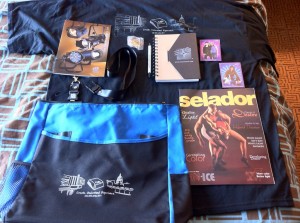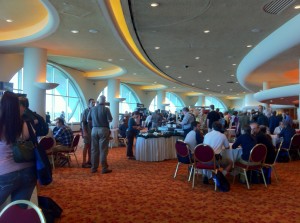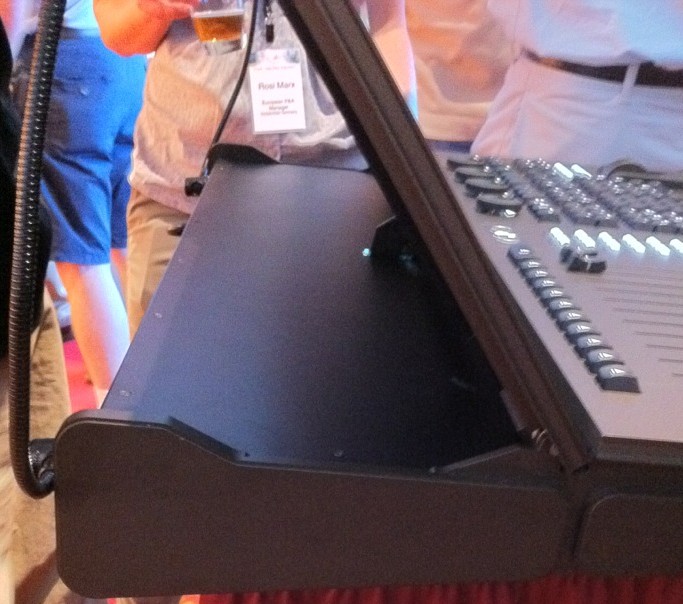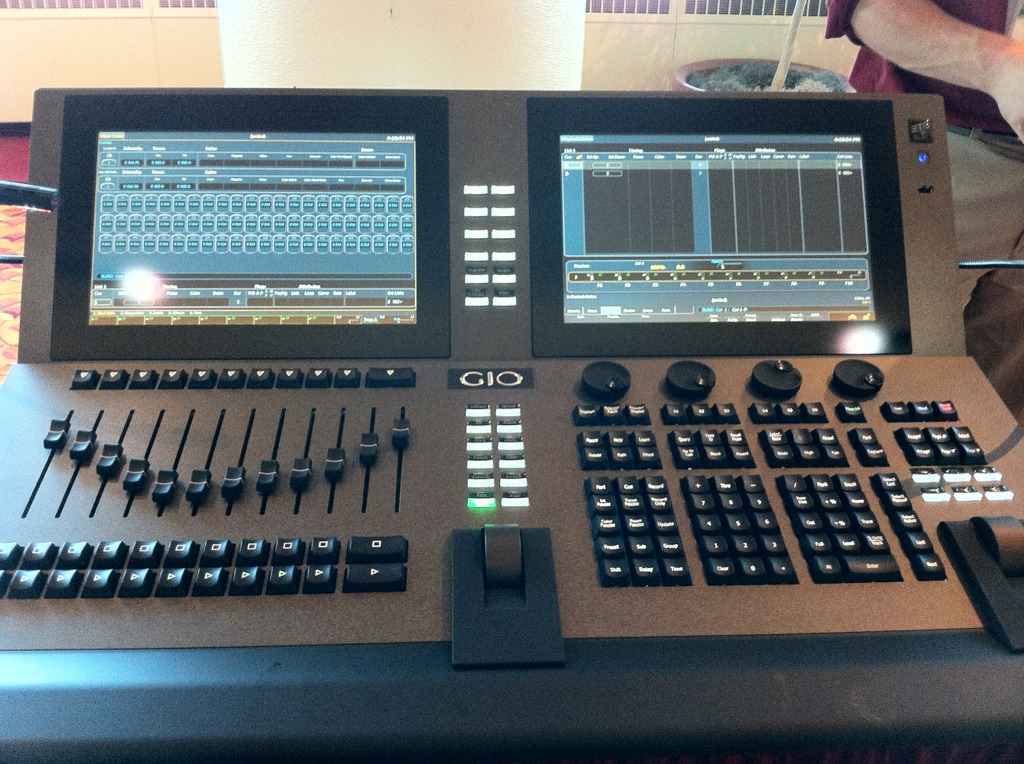 Last week, around 180+ folks attended the inaugural ETC end users conference known as ETC Cue. It was overheard that it was about 2 years in the making, and the preparation certainly showed.
Last week, around 180+ folks attended the inaugural ETC end users conference known as ETC Cue. It was overheard that it was about 2 years in the making, and the preparation certainly showed.
 Upon arriving, conference goers were given their schedule (the registration process required us to choose which sessions we were initially interested in, although Tuesday and Wednesday sessions were considered “open” but more on that later) as well as an awesome, and quite useful, goodie bag containing a T-Shirt, pen and notepad, ETC pin, Selador newsletter, presenter trading cards, fixture line literature, and of course the bag itself. The coolest is the nametag and lanyard: the lanyard itself is a USB flash drive, which contained the powerpoint presentations of the whole conference, plus practice workbooks for the consoles! As an educator, this part caused a fair bit of giddiness.
Upon arriving, conference goers were given their schedule (the registration process required us to choose which sessions we were initially interested in, although Tuesday and Wednesday sessions were considered “open” but more on that later) as well as an awesome, and quite useful, goodie bag containing a T-Shirt, pen and notepad, ETC pin, Selador newsletter, presenter trading cards, fixture line literature, and of course the bag itself. The coolest is the nametag and lanyard: the lanyard itself is a USB flash drive, which contained the powerpoint presentations of the whole conference, plus practice workbooks for the consoles! As an educator, this part caused a fair bit of giddiness.
The first official day was Monday July 25th, which was a pre-conference day (beginning with breakfast) where attendees could choose to register for a console-programming class (with their initial registration) or take a detailed factory tour, followed by an evening welcoming reception.
This attendee chose the console-programming route and was lucky to be placed in a class led by Anne Valentino, Nick Gonsman, and Peter Weigand for advanced programming. The first surprise of the conference was in these programming classes, where we learned that we in the Eos Family were to be training on software version 1.9.8, which is currently in closed beta and suggested to be released in the 4th quarter, near September.
For those curious on the topics discussed, our class created a list of items we wanted to know more about. We covered: the changes that are coming in the software (including a new “shift” key to facilitate new commands, startup and shutdown macros, and the ability to dim the console’s LED Littlelites). We focused on terminology and process: learning about background space vs. foreground space, workflow (referenced vs. absolute data), locking palettes, how the console “sees” the differences between Record and Record Only, Selective Storing, Filters, Null Data, Shielded Subs, Block and Assert, tips on marking, working with multiple cue lists, working with Query, working with Trace, Sub mapping, timing on Subs, and altering time by percentage. By 4 pm we were armed with pages of notes and pleasantly saturated brains.

 The welcome reception gave us a chance to decompress and network with old and new friends over a passel of appetizers (and the mashed potato martinis deserve a mention). Most of the reception was a blur however once the Gio consoles were rolled into the room. Everyone crowded hungrily around the three consoles; eager to hear everything the ETC representatives could tell us about them.
The welcome reception gave us a chance to decompress and network with old and new friends over a passel of appetizers (and the mashed potato martinis deserve a mention). Most of the reception was a blur however once the Gio consoles were rolled into the room. Everyone crowded hungrily around the three consoles; eager to hear everything the ETC representatives could tell us about them.
As highlighted earlier, this desk is intended to fit between the Ion and the Eos, literally and figuratively, as the physical size indicates as well as the output/address configurations. It will support the same protocols (Net 2 and Net 3, as well as DMX) as their other consoles, and can support up to 3 additional external monitors (DVI, or VGA with an adaptor). The soft keys and other control buttons lie in between the fader area and the keyboard area, and their corresponding labels are also backlit. There are 8 non-labeled soft keys that are placed between the touch screens; presumably these are additional multi-functional soft keys and/or user definable macro keys. The keys at the top of the faders are the load keys, and the faders are motorized. The keys below are the same Stop/Back and Go buttons, but are marked with the universal square symbol for Stop (backlit in red) and triangle “play” (backlit in green). All of the console keys are backlit, are user configurable as far as brightness, and will dim out after a set amount of time. The encoder wheels on this console are above the control keypad area, and utilize the right hand touch screen for their page navigation. There are no slots for button modules, as in the Eos console. The internal screens appear smaller than the 15” screens of the Eos, but it fits well with the form factor (and appear to be a higher resolution).  The repositionable screens are a highlight; they are super thin, hinge at the bottom of the screens (the pivot can be seen behind the screens at the center bottom on the image to the right) and the folding action operates with one hand via a button at the top in the middle and allows the screens to fold down at any position from up to completely flat. The coating on the metal is so scratch resistant, that when one of the reps took a quarter and scrubbed it over the fascia, it wiped clean. More information will be forthcoming soon, as we heard that it is slated to be in the area reps hands in September.
The repositionable screens are a highlight; they are super thin, hinge at the bottom of the screens (the pivot can be seen behind the screens at the center bottom on the image to the right) and the folding action operates with one hand via a button at the top in the middle and allows the screens to fold down at any position from up to completely flat. The coating on the metal is so scratch resistant, that when one of the reps took a quarter and scrubbed it over the fascia, it wiped clean. More information will be forthcoming soon, as we heard that it is slated to be in the area reps hands in September.
What a great end to the first day of the first ETC Cue conference! The recap of day 2 will come in ETC Cue: Recap part 2.
LatestHeadlines
- Upgrading Your Toolbox: City Theatrical DMXcat-E and DMXcat Multi Function Test Tool
- Claypaky Bringing Back the Sexy to Par Cans with the Midi-B FX
- Ayrton Evolves the Cobra, the Cobra2 Developed for the US Market
- MA Lighting Intros grandMA3 onPC Fader Wing and DIN-Rail Nodes
- Live Events LEVL Up Fest: A Festival to Aid our Industry
